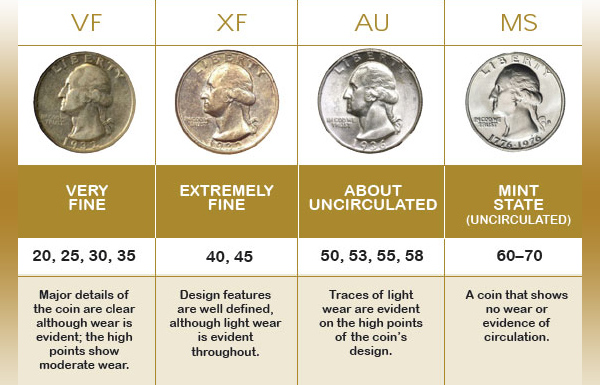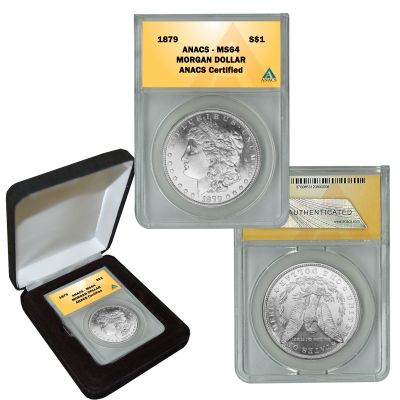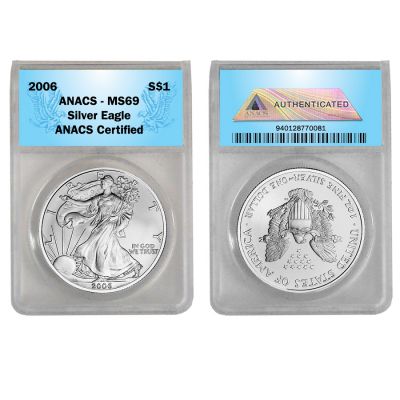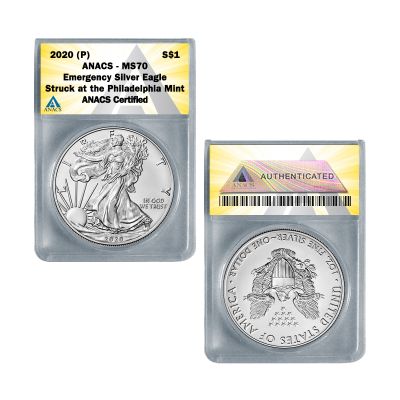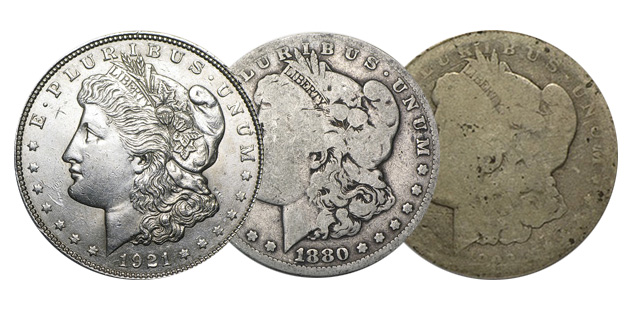When looking for coins to collect, you may find some in a plastic case that is designated with a grade, such as MS70. That plastic case is referred to as a slab and is sonically sealed to protect the coin from dust, fingerprints, and anything else that may lower its worth.
What are these numbers or “grades” and what do they represent? Should you collect graded coins at all? And is a graded coin worth more than an ungraded, or what is often called a “raw” coin?
Let’s explain what graded coins are and how they play a role in the industry.
One of my earliest memories of coin collecting was when I was perusing my brother’s fake alligator suitcase and found a bunch of coins in cardboard holders with VF36 or VG9 written on them. My older brother was by no means rich, but he was a paperboy and had access to a lot more coins than most kids his age. And to be honest, I was more excited when he came home with a bag of penny candy instead of another coin in a cardboard holder.
Nowadays, it seems many collectors are more concerned with grades like MS69 or MS70 or PR68. Way out of my paperboy brother’s league. What does it all mean?
Coins are graded on a scale of 1 to 70. Who came up with 1 to 70? Obviously, not a student of metrics. This unusual scale for grading was created by a fellow named William Herbert Sheldon in 1949. W.H. Sheldon was a Psychologist and Professor of Medicine who served as a lieutenant colonel in the Army during WWII and also dabbled in Numismatics.
Initially, the scale was rather basic – here’s an abbreviated version:1
| # | Grade |
|---|---|
| 1 | Basal State – in other words, you knew the piece of metal was once a coin |
| 4, 5, 6 | Good |
| 7, 8, 10 | Very Good |
| 12, 15 | Fine |
| 20,30 | Very Fine |
| 40 | Extremely Fine |
| 50 | About Uncirculated |
| 60 | Mint State |
| 70 | Mint State |
By the 1970s the American Numismatic Association modified and expanded the scale to form a more detailed, comprehensive look at coin grades; here is another abbreviated version, the complete scale can be found here.
It is very comprehensive, indeed. Except for the description “dull or washed-out, mint luster typify this coin” (MS60) can be very subjective. It’s not a science; it’s an art.
For example, what’s the difference between some scratches on a new circulated coin and a few bag marks on an uncirculated coin? At least with lower grades, it gets a little easier, because you know that you’re dealing with circulated coins. As you get into higher grades, four elements come into play:
1. Surface – the number of imperfections or flaws that are on the surface of the coin. Keep in mind, many of these are caused during the manufacturing process. Bag marks, scratches, friction, some coins, like the newer golden dollar alloys, will have spots and stains that are inherent to the composition of the metal. Older silver coins may exhibit toning – which is discussed in more detail under “Eye Appeal.”
2. Strike – when a coin is made, it starts as a blank or “planchet.” It is struck with a die. Coin dies have a limited lifetime. After about 100,000 coins are made, the die starts to wear out and will produce coins whose details are not as sharp. This is why many times you will see the words “First Strike” or “First Day of Issue” (FDOI) describing a graded coin. Coins with sharp, crisp details are more valued.
3. Luster – Luster refers to the coin’s light-reflective qualities. As you hold your coin (by the edges and with gloves) and rock it back and forth, you can see how the light reflects off of it. This is often called the cartwheel effect. This site gives a more detailed explanation of coin luster.
4. Eye Appeal –Eye appeal is also the most subjective quality of a coin. Luster plays a big part in eye appeal. Toning is also a critical factor in eye appeal. Toning on a coin is the change of color caused by oxidization, which forms a thin layer of tarnish on the metal’s surface. Some people feel all toning detracts from the appeal of a coin. Sometimes it can give a beautiful, subtle rainbow effect. Coins that have been cleaned have the toning removed, but they also decrease in value as a result. Similarly, coins that have been artificially toned have a reduced value.
Once you start avidly collecting, it’s easier to spot the artificially toned coins – they’re typically more vibrant in color and more uniform in appearance. Silver and copper coins are more subject to toning. Believe it or not, older pennies like Wheat Backs that appear brown are toned coins.
So, as you can see, a lot of experience and education are needed to grade a coin accurately.
Who do you go to when you want a coin graded? The guy at the flea market with the fake alligator suitcase? No.
Reputable grading companies should only perform grading. They are often referred to as TPGs, which is an acronym for THIRD party grading. 3rd party means that while they grade coins, they don’t sell them. They charge you a fee to grade your coin. They have no incentive to give it a higher or lower grade. They’re trained experts, and you should expect them to be fair and honest.
The top four grading companies are ANACS, PCGS, NGC, and ICG, with ANACS being the oldest. To grade a coin, you go to their websites and download a submission form. Ship the coin to them using an insured service (depending on the coin’s value) together with the form.
After they grade it, your coin is returned to you in a sonically sealed holder, with a label stating the coin, the year, the mint mark, and the grade. It will have its own bar code and individual number. The grading company will keep a record of your coin using that number.
You can also buy a coin already graded. Companies that sell graded coins often grade in bulk, and as such, pay lower grading fees and pass savings on to you. The guarantee is the same.
Is it worthwhile to grade?
Let me share with you a personal experience. Back in the early seventies, my father used to purchase mint and proof sets directly from the Mint. Because he was on their mailing list, he was one of the first in line to purchase three GSA Morgan Dollars. GSA Morgan Dollars were leftover, uncirculated bags of Morgan Silver Dollars that the Treasury found whenever they did inventory, many of them from the Carson City Mint. My father paid $14 a coin. Twenty-five years later, went my father passed away, my mother gave me the coins to sell. They were in pristine condition! When I sent them off to be graded, two were graded MS64, and one was an MS65, which for Morgan Dollars are a very high grade.
We sold them then for slightly less than $1000 each. Today, those same coins are selling for two to three times more than that. (Ouch!)
Does having a coin graded always make it more valuable? Not necessarily. But, if I hadn’t gotten those GSA Morgans graded, their grade/value might be in question. Knowing that a TPG company determined the grade made it easier for me to sell and for the buyer to feel confident about their purchase.
There’s a lot of debate in the industry over the current practice of grading of modern coins. Many feel that unless the coin has a minimal mintage, it’s not worth the expense. Today, the US Mint produces much higher quality coins because they use a modern, sophisticated minting process.
Due to the proliferation of high-quality counterfeit coins from foreign countries, I prefer to pay a premium to have my coin graded, not just to confirm the quality, but also the authenticity of the coin. (Grading companies are usually able to spot fakes in their inspection.)
Scottsdale Bullion & Coin writes: “The bottom line is that a high mint state doesn’t make a coin rare. In most cases, when companies are selling coins in high grades, they are not and are likely never going to be rare. The mintage number is too high for most of these certified coins for them to ever compare to early American coins that are truly scarce in mint state condition. It’s a different market.” 3
A different market indeed. On April 30, 2020, it was reported that the current enormous demand and limited supply of silver and gold bullion coins and other precious metals items during the COVID-19 pandemic had created a breeding ground for the distribution of counterfeits that are costing unsuspecting investors millions of dollars, according to the nonprofit Anti-Counterfeiting Educational Foundation.4
What would a virus have to do with counterfeit coins? Well, in times like these people get very nervous about both paper and electronic money. They want something tangible. Many of the fake sellers use legitimate-looking websites that may appear to be legitimate US based businesses, but the “gold and silver” items they offer are usually priced far below actual market value. They’re also not made of real gold or silver. I have seen 4 or 5 Facebook ads that use Patriotic Mint’s image (stolen, of course) for advertising Silver Eagles for $12.95 or less. As an authorized dealer, it’s frustrating, but that is nothing in comparison to customers getting ripped off by fakes.
CoinWeek reports that a survey done by the Anti-Counterfeiting Task Force revealed that 43.3 percent of US coin dealers reported encountering customers seeking to sell them counterfeit silver American Eagle bullion coins. Similarly, 41.2 percent report customers trying to sell them fake gold American Eagle bullion coins. Beth Deisher, the Industry Council for Tangible Assets Director of Anti-Counterfeiting. “Counterfeiters — primarily from China — target the most popular products, usually market leaders with the highest brand identification.” 5 She also cited survey results in two other categories – bullion bars and collectible classic US coins. Never buy US coins from China. It is illegal to ship US Coins, even pennies, into China. That being said, there is no way genuine Silver Eagles are coming from China. Unfortunately, these websites are crafty, which is why I caution buyers or new collectors to only buy from well-known and trusted dealers.
Bottom line: if getting a graded coin gives you more security, I readily encourage doing so.
Things to remember:
• Grading is an art, not a science.
• Know your third party grader – and make sure they’re an unbiased grader
• Grading instills confidence and trust between the seller and the buyer.
• A grade doesn’t necessarily increase a coin’s value, but it does secure it.

